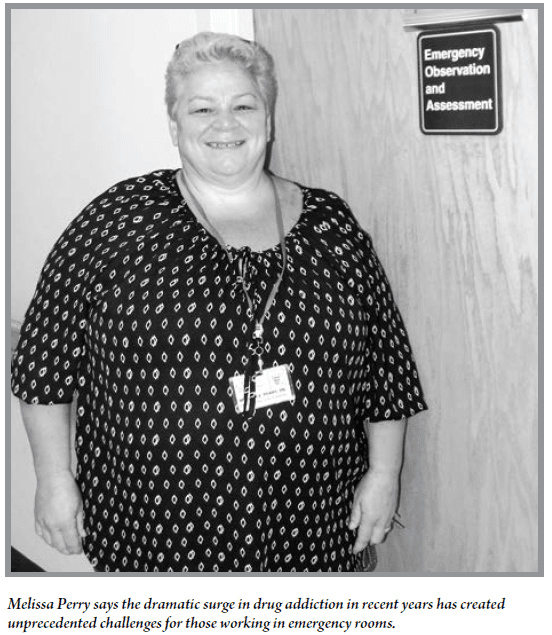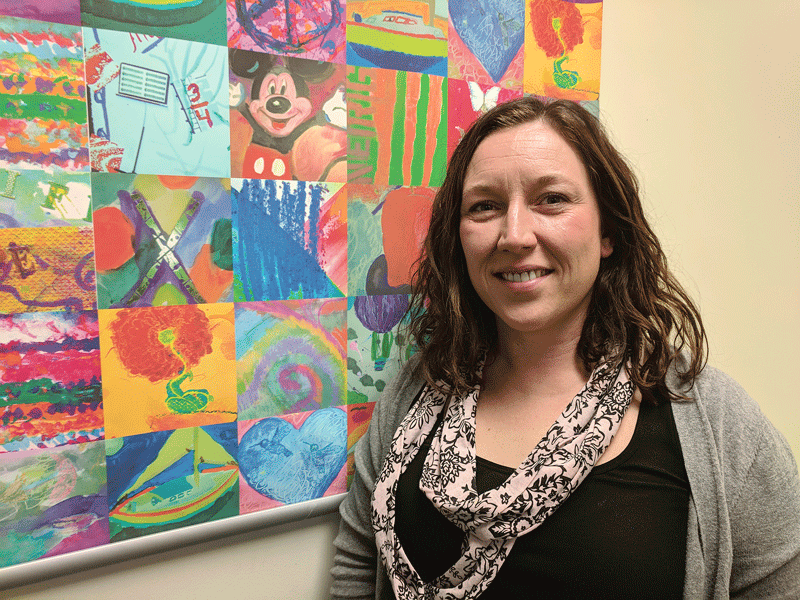A Big Step Forward – Grant Will Enable HMC to Improve ER, Behavioral Health Services
The news that Holyoke Medical Center has received a $3.9 million grant from the Mass. Health Policy Commission couldn’t have come at a better time for the hospital and its patients.
Indeed, for Baxter Chandler, HMC’s director of Behavioral Health Services, and his staff, change in the form of a host of improvements to the hospital’s Emergency Department, can’t arrive soon enough.
Incidences of hospitalization resulting from behavioral health issues and drug addiction have never been higher than in recent years, said HMC officials. With the hospital’s emergency room staff often stretched to its limit by influxes of patients suffering from problems related to mental health or addiction, the quality and efficiency of the care individuals receive has not been at optimal levels.
But that’s all about to change over the course of the next year.
The recently allocated grant monies will allow HMC to incorporate a new behavioral health emergency department within its existing emergency room. Not only will the ER experience a physical renovation, but the hospital’s entire behavioral health program will be overhauled to help reduce the pressure on the staff.
“This funding will allow us to create significantly improved conditions for all our patients, especially those with behavioral health needs,” said HMC President and CEO Spiros Hatiras. “Programmatic changes and designated treatment space for behavioral health patients in the Emergency Department will help to avoid unnecessary hospitalization and reduce re-hospitalization of behavioral health patients.”
The Mass. Health Policy Commission grant was awarded as part of phase 2 of the agency’s Community Hospital Acceleration, Revitalization, and Transformation Investment Program (CHART). More than $60 million in grant monies have been disbursed to hospitals throughout the state during phase 2 of the program, with the directors of each facility deciding how to best utilize the funds. The total funding available through the CHART Investment Program is nearly $120 million.
Since phase 2 of the CHART program is a two-year grant, HMC officials will need to act quickly to implement the changes. Once in place, they are hoping the new department will become sustainable.
Combating the Epidemic
Melissa Perry, HMC’s director of Behavioral Health Nursing, has been with the hospital for 20 years. Throughout her career she has seen plenty of ups and downs in the battle against substance abuse, but she can’t recall a time when drug addiction was as rampant as it is now in area communities, especially among young people.

With easier access to prescription painkillers and other drugs around the house, the problem is starting earlier for many youngsters, she said, and leading to advanced addictions by their high school years.
For hospitals — particularly emergency departments — the combination of behavioral health problems and drug addiction creates a recipe for disaster. Patients have often been admitted after displaying signs of both behavioral and drug-related distress, and far too frequently those same patients were readmitted in a matter of weeks or months because they weren’t connected to the right care options or didn’t follow through with their treatment plans, Perry explained.
Lack of coordination between patients, caregivers, and treatment specialists has been a glaring deficiency throughout the state, resulting in far too many individuals falling through the proverbial cracks, she siad.
Meanwhile, the closure of rehab facilities has only exacerbated the problem. In many instances, patients have no idea where to turn for assistance with their treatment plans.
“The behavioral health system has been broken,” said Perry, who noted that many area detox centers have shut down or reduced their number of beds in recent years.
“There were changes in the way the Department of Mental Health approaches the care of patients, and several patients wound up losing seasoned case managers,” she told HCN. “That led to a huge increase in people using the emergency department.
“Substance abuse has increased dramatically with young and middle-aged people,” she went on. “We’ve seen over the past 10 years decreased access to substance abuse treatment.”
At HMC, the behavioral health department focuses on both mental health and addiction emergencies. Many of them, Chandler said, wouldn’t require admission or readmission to the emergency room if the system was improved. With HMC’s new model, patients will be more quickly assessed and, if applicable, transferred from the emergency room to the behavioral health emergency department.
Additionally, the new department will be far better prepared to instantly connect patients with the appropriate services and supports.
“Part of this is sustainability,” Chandler said. “Once we create this department, we want to show that we can reduce readmissions to the emergency room for behavioral health and substance abuse patients.”
Chandler noted that it is very costly, not to mention inefficient, when patients keep returning to the emergency room due to problems that were not solved by a strained system. Currently, patients sometimes have to wait for months to be enrolled in the correct psychiatric recovery program and receive access to medications. Many of them abandon the process before they even enter the proper programs, only to wind up back in the emergency room with the same unaddressed issues.
“If we can start treatment earlier, we can prevent many of these patients from having to return to the emergency room,” said Chandler.
Streamlined Service
The new-look HMC behavioral health program is expected to treat six mental health patients and six substance abuse patients at any given time. Moreover, the program will offer patients 24-hour psychiatric services, including access to medications.
“If you’re a behavioral health patient, your stay will be much more lengthy than the average medical stay,” added Perry, who explained that the process of psychiatric evaluation and care involves several steps.
No longer needing to be triaged and treated by an often-overburdened general ER staff, future patients will experience much more immediate and comprehensive care once the new system is operational. HMC has already begun the process of preparing two per-diem nurses for the conversion to full-time roles in the new program, and additional staff members will be hired externally. In a committed effort to reduce readmissions, specially trained care navigators will place an emphasis on recovery initiatives and follow-up care.
That way, patients will know exactly where to turn for guidance following their release from the hospital.
“The role of the care navigator is to make sure patients connect with the right doctors and specialists once they leave the hospital,” Chandler told HCN, describing the new system as a lynchpin for the behavioral health department.
As part of the focus on recovery, HMC will also work closely with its sister affiliate, River Valley Counseling Center, to introduce patients to a host of outpatient therapists and outreach programs. River Valley boasts a strong staff of therapists, and HMC officials said the relationship between affiliates will be integral to success moving forward.
Of course, the new system won’t be solely beneficial to behavioral health patients. The ER staff will experience a marked reduction in admissions and readmissions once the system is running, which means quicker access to care for all patients. By immediately identifying behavioral health and substance abuse patients, then transferring them to the proper channels, the pressure of ER overcrowding will be vastly alleviated.
Unfinished Business
Even with the $3.9 million grant, the HMC behavioral health team still has a long way to go in order to institute its new system. Chandler said the total project cost is $7 million, and the hospital will soon begin a capital campaign fundraising endeavor to help defray the remaining costs. Much of the money will fund construction efforts, as the emergency department needs to undergo significant renovations to accommodate the new treatment area.
Meanwhile, the processes of readying staff members and preparing protocol are already underway. Chandler said the renovation of the emergency room should begin soon, and the new system is expected to be fully operational by the middle of 2015.
HMC currently offers a 20-bed inpatient ward, as well as a partial hospitalization and intensive outpatient program. The HMC emergency department, which serves more than 45,000 patients per year, will continue normal operations through the redesign and construction phases of the project.
To be eligible to receive CHART funds, hospitals throughout the state must meet certain requirements. Institutions that are awarded such funds include non-profit, non-teaching community hospitals, as well as acute care hospitals of varying size and affiliation. Massachusetts HPC Commissioner Paul Hattis said the purpose of the CHART Investment Program is to accelerate the transformation of healthcare in Massachusetts by maintaining access to care in community settings.
If all goes as planned, the improvements at HMC’s ER will do just that.



Comments are closed.